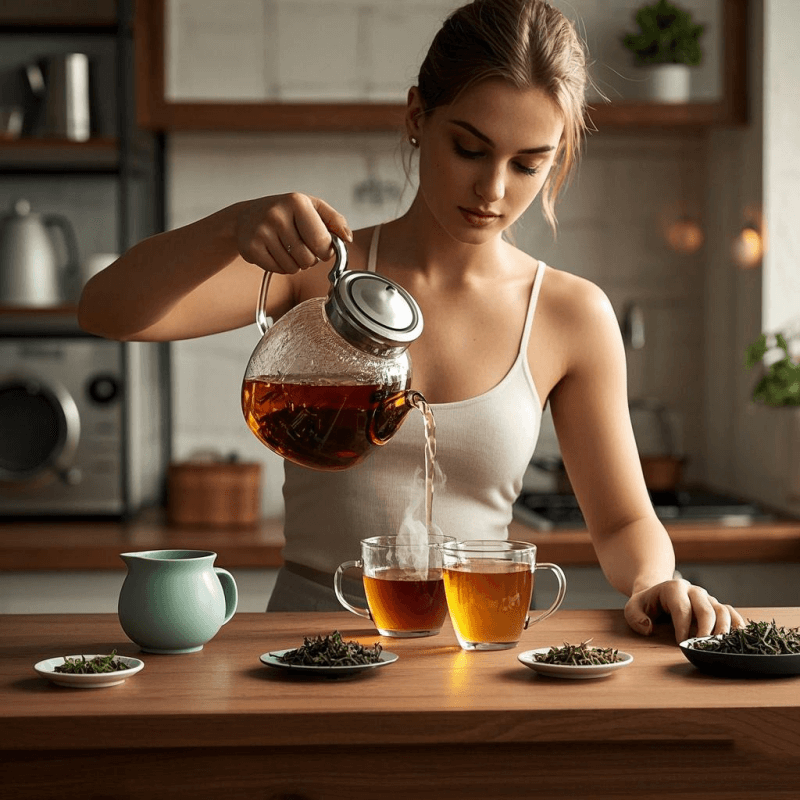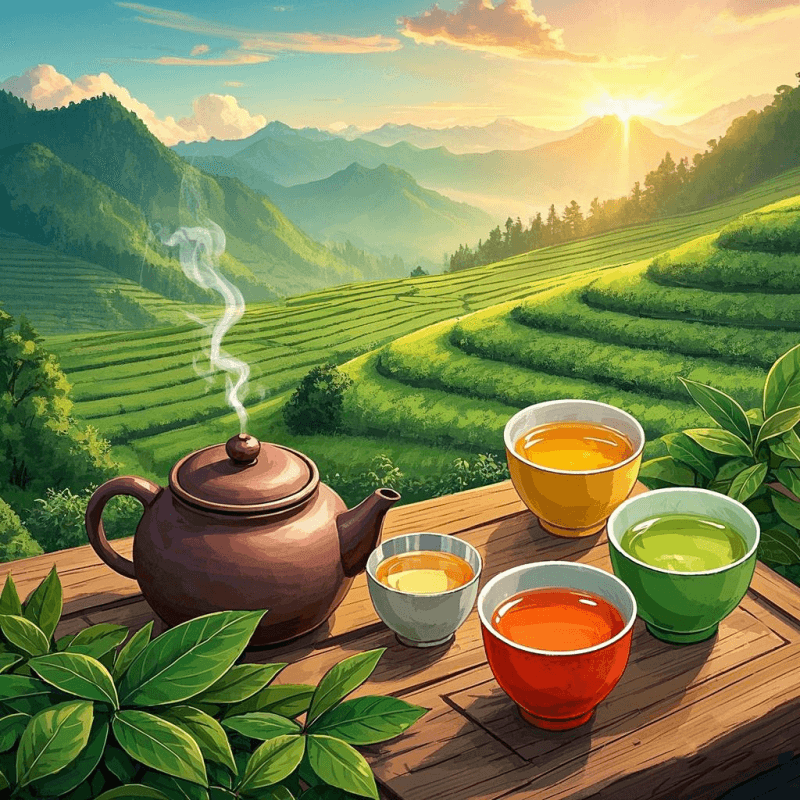1. Introduction: Why Compare Oolong Tea Leaves to Other Teas?

With so many tea options lining store shelves, choosing the right one can feel overwhelming. From vibrant greens to robust blacks, each type offers unique benefits—but few balance flavor, versatility, and wellness perks like oolong tea. Understanding what sets its leaves apart helps you make choices that align with your taste, energy needs, and health goals. This guide breaks down how these semi-oxidized leaves stack up against other popular teas, so you can sip confidently.
2. What Makes Oolong Tea Leaves Unique?
Not all tea leaves are created equal, and the semi-oxidized variety stands out for its meticulous production and distinctive properties. Here’s what makes them special:
🌱 The Art of Semi-Oxidation
Unlike green tea (minimally oxidized) or black tea (fully oxidized), these leaves undergo controlled oxidation—typically 10–80%—shaped by skilled tea masters. This process develops complex flavors (from floral to roasted) while preserving key compounds like catechins and theaflavins. The result? A brew that’s neither too delicate nor too bold, with a depth that evolves across multiple steepings.
🍃 Terroir and Craftsmanship
Grown in mountainous regions with ideal soil and climate, the leaves absorb unique mineral profiles that influence taste. Traditionally hand-rolled and dried, they retain more natural oils and nutrients than mass-produced alternatives. Discover the finest oolong tea leaves sourced from top mountains to experience this craftsmanship firsthand—each batch reflects the land and skill behind it.
🍵 Sensory Versatility
From light, buttery varieties to rich, toasty blends, these leaves adapt to diverse preferences. Their aroma shifts with oxidation levels: lighter batches offer honey or orchid notes, while darker ones reveal caramel or woody undertones. This range makes them a favorite for both casual sipping and ceremonial brewing.
3. Oolong Tea Leaves vs Green Tea: Key Differences
While both come from the Camellia sinensis plant, their processing creates distinct profiles:
🔄 Oxidation Impact
Green tea leaves are steamed or pan-fried immediately after harvesting to stop oxidation, preserving their bright color and grassy flavor. In contrast, the semi-oxidized variety develops deeper flavors and a warmer hue through controlled exposure to air. This difference also affects their nutrient makeup—green tea is higher in catechins, while its counterpart offers a balanced mix of catechins and theaflavins.
☕ Caffeine Content
A 8oz cup of green tea typically contains 20–45mg of caffeine, while the semi-oxidized option ranges from 30–50mg. This moderate boost provides steady energy without the jitters, making it ideal for midday sipping when you need focus without crashing.
🍽️ Flavor Pairings
Green tea’s crispness pairs well with light meals or desserts, while the richer, more nuanced profile of the semi-oxidized leaves complements savory dishes, spicy foods, or even dark chocolate. Their versatility shines in both hot and iced preparations.
4. Oolong Tea Leaves vs Black Tea: Flavor and Caffeine Showdown
Black tea’s bold character makes it a morning staple, but how does it compare to its semi-oxidized cousin?
🔥 Oxidation and Taste
Black tea leaves undergo full oxidation (80–100%), resulting in a robust, malty flavor and dark color. The semi-oxidized variety, with its partial oxidation, strikes a middle ground—offering complexity without overwhelming bitterness. This makes it a great transition for those who find black tea too strong but green tea too mild.
⚡ Caffeine Comparison
Black tea typically packs 40–70mg of caffeine per cup, slightly more than the semi-oxidized option. For those sensitive to caffeine, the latter provides a gentler lift, making it suitable for afternoon consumption without disrupting sleep.
🍵 Brewing Flexibility
Black tea often requires shorter steeping times (3–5 minutes) to avoid bitterness. The semi-oxidized leaves, however, thrive with multiple steepings—some varieties yield 5–7 cups, with each infusion revealing new flavor layers. Enhance your tea journey with traditional brewing tools from Yihe to explore this versatility fully.
5. Health Benefits: How Oolong Tea Leaves Compare to Other Teas
All teas offer wellness perks, but the semi-oxidized variety brings a unique blend of benefits:
🌿 Antioxidant Balance
Green tea leads in catechins, while black tea is rich in theaflavins. The semi-oxidized leaves offer both, creating a synergistic effect that supports cellular health. A 2022 study in Nutrition Research found regular consumption increases plasma antioxidant activity by 18%, comparable to green tea but with more sustained benefits.
❤️ Heart Health Support
Research shows consistent tea drinking benefits cardiovascular health, but the semi-oxidized option stands out for cholesterol management. A 10-year study in The American Journal of Clinical Nutrition linked daily consumption to a 20% lower risk of heart disease, outperforming black tea in similar trials. As Healthline notes, “Its balanced compounds support long-term heart wellness.”
🧠 Mental Clarity
Thanks to L-theanine (an amino acid) and moderate caffeine, the semi-oxidized variety promotes calm focus—more so than black tea, which can cause jitters, or green tea, which may offer less sustained energy. This combination makes it ideal for work or study sessions.
6. How to Choose the Right Tea for Your Lifestyle

Your daily routine and preferences should guide your tea choice. Here’s how to decide:
🕒 For Morning Energy
If you need a strong kick, black tea works—but for steady energy without crashes, the semi-oxidized variety is better. Its moderate caffeine pairs with L-theanine to keep you alert without anxiety.
🍽️ For Digestive Support
Rich in polyphenols that aid digestion, these leaves shine after meals. Unlike green tea, which can sometimes irritate sensitive stomachs, their mellow profile is gentler on digestion.
🍵 For Flavor Exploration
If you enjoy experimenting with brewing, the semi-oxidized leaves are perfect. Their ability to steep multiple times lets you discover new notes with each cup. Learn the differences between oolong tea leaves and other tea types to refine your palate further.
🌙 For Evening Relaxation
Opt for low-caffeine green tea or herbal blends at night, but if you crave a warm drink earlier in the evening, a lightly oxidized variety (with 10–20% oxidation) works well, as its caffeine content is minimal.
7. User Insights: Why Tea Lovers Choose Oolong Tea Leaves
Real drinkers highlight what makes this variety a staple:
- “I switched from black tea because I wanted less bitterness but more flavor than green tea. These leaves hit the perfect balance!” — Emma, 31, yoga instructor
- “I love that I can steep the same leaves all afternoon. Each cup tastes a little different—never gets boring.” — James, 45, writer
- “It’s become my post-lunch ritual. Helps digestion without the jitters I get from coffee.” — Priya, 28, dietitian
8. Conclusion: Why Oolong Tea Leaves Make a Smart Choice
When comparing teas, the semi-oxidized variety stands out as a versatile, flavorful, and wellness-focused option. It bridges the gap between green and black teas, offering balanced caffeine, complex taste, and diverse health benefits—all while adapting to your lifestyle, whether you’re a morning energizer or an afternoon sipper.
Browse our premium oolong tea collection for your ideal flavor to experience these benefits firsthand. With its rich craftsmanship and adaptable nature, this tea proves that sometimes the best choices are the ones that strike a perfect balance.
Savor the taste of oolong tea with traditional brewing tools from Yihe and elevate your daily ritual—one steep at a time.
As WebMD notes, “Oolong tea leaves provide a unique blend of antioxidants and flavor that sets them apart from other tea varieties.”
